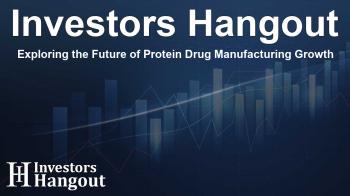Exploring the Future of Protein Drug Manufacturing Growth

The Rising Landscape of Protein Drugs
As the healthcare industry evolves, protein drugs are making waves, fundamentally changing the approach pharmaceutical companies take to manage chronic and life-threatening conditions. With a surge in demand for precise biologic-based therapies, leading pharmaceutical firms have been diligently working on solutions that not only enhance treatment efficacy but also broaden patient accessibility. Companies like AbbVie, Novo Nordisk, and Sanofi are at the forefront, pushing the envelope with next-generation technologies.
Market Trends and Insights
The latest market reports highlight a significant growth trajectory for the protein drugs sector. Projections indicate that the market size is set to soar from $441.7 billion in the current year to approximately $655.7 billion by 2029, achieving a compound annual growth rate (CAGR) of about 8.2%. This growth is primarily fueled by several factors, such as the rising incidence of cancer, advances in biologics production technologies, and an expanding pipeline of biosimilars that offer competitive alternatives in the therapeutics market.
Emerging Manufacturing Techniques
The shift from specialty applications to mainstream medicinal use is primarily supported by innovative manufacturing platforms. Techniques such as cell culture and microbial fermentation are being harnessed to facilitate cost-effective production of crucial therapeutic agents. This modernization is key to making life-saving medications more accessible to broader patient populations.
Investment and Strategic Collaborations
Accelerated innovation within the protein drug landscape has been bolstered by venture capital infusion, collaborative licensing agreements, and international co-development initiatives. These partnerships are vital for advancing technologies like AI-assisted protein modeling and optimizing drug launch strategies. As the sector evolves, fusion proteins and advanced vaccines are drawing significant investment, reflecting strong potential in previously underserved therapeutic domains.
Investment Opportunities and Challenges
With the competitive landscape in constant flux, strategic maneuverings among top pharmaceutical companies are reshaping market dynamics. Many firms are simultaneously pursuing organic research and development alongside mergers and acquisitions to fortify their market positions. Emphasis is also being placed on biosimilar production and automated biomanufacturing as strategies to reduce costs and improve efficiencies.
Technological Advancements Driving Change
Central to the expansion of the protein drugs market are ongoing technological advancements that influence everything from production processes to drug delivery mechanisms. Continuous manufacturing methods and innovative protein stabilization approaches are helping optimize drug yield and maintain product quality. Emphasizing sustainability, leading companies are integrating Environmental, Social, and Governance (ESG) goals into their core strategies.
The Importance of Sustainability
Sustainability initiatives are becoming increasingly integral to corporate strategies within the protein sector. Companies are committing to environmentally friendly processes, from using green bioprocessing methodologies to minimizing energy consumption during manufacturing. This shift not only enhances corporate responsibility but is also becoming a decisive factor in procurement and investment evaluations.
Conclusion
The protein drugs market is on the brink of major advancements and opportunities. As healthcare systems around the globe continue to prioritize innovative treatments and sustainable practices, market participants must remain agile and adapt to the shifting dynamics. By embracing technology, fostering collaboration, and maintaining a dedication to environmental consciousness, the industry can look forward to a promising future characterized by significant growth and enhanced patient outcomes.
Frequently Asked Questions
What drives the growth of the protein drugs market?
The primary drivers include technological innovations in biologics production, increased cancer incidences, and the expansion of biosimilar pipelines.
Which companies are leading in the protein drug sector?
Market leaders include AbbVie, Novo Nordisk, Sanofi, and Pfizer, among others, known for their substantial contributions to therapeutic advancements.
How significant is the market growth predicted for the upcoming years?
The market is anticipated to grow substantially, reaching $655.7 billion by 2029, fueled by a CAGR of 8.2%.
What are the emerging trends in protein drug manufacturing?
Emerging trends include scalable manufacturing techniques, strategic collaborations, and a focus on sustainability within production processes.
What role does sustainability play in the protein drug market?
Sustainability is increasingly prioritized by companies aiming to reduce environmental impact and improve their competitive positioning in the market.
About The Author
Contact Olivia Taylor privately here. Or send an email with ATTN: Olivia Taylor as the subject to contact@investorshangout.com.
About Investors Hangout
Investors Hangout is a leading online stock forum for financial discussion and learning, offering a wide range of free tools and resources. It draws in traders of all levels, who exchange market knowledge, investigate trading tactics, and keep an eye on industry developments in real time. Featuring financial articles, stock message boards, quotes, charts, company profiles, and live news updates. Through cooperative learning and a wealth of informational resources, it helps users from novices creating their first portfolios to experts honing their techniques. Join Investors Hangout today: https://investorshangout.com/
The content of this article is based on factual, publicly available information and does not represent legal, financial, or investment advice. Investors Hangout does not offer financial advice, and the author is not a licensed financial advisor. Consult a qualified advisor before making any financial or investment decisions based on this article. This article should not be considered advice to purchase, sell, or hold any securities or other investments. If any of the material provided here is inaccurate, please contact us for corrections.

